EMC Question of the Week: June 23, 2025

A shielded cable with twisted wire-pairs carrying high-frequency signals connects to a circuit board mounted in a plastic enclosure with no metal chassis. The circuit board has a solid copper GND/RTN plane. In this situation, the shield of the cable should almost always connect
- directly to the plane
- to the plane through a resistor
- to the plane through a TVS diode
- to nothing
Answer
The best answer is “a.” The main purpose of the cable shield, in this case, is to return any common-mode current on the signal wires back to the source. Voltage between the PCB EMC ground and the cable shield will drive a common-mode current on the outside of the shield. Also, impedance between the cable shield and PCB EMC ground provides a means for externally induced common-mode currents on the shield to be converted to differential noise in the signal lines.
There is virtually no situation where this connection should be filtered through any kind of a series impedance. A floating cable shield (i.e., connected to nothing) serves no purpose other than perhaps providing some low-frequency electric-field shielding in certain specific situations.
Note: In some systems, connecting a cable shield to a circuit board ground may not be allowable due to "ground loops." This is a clear indication that poor choices were made during the system-level design. Nevertheless, a high-frequency connection to the PCB ground will be necessary for the shield to do its job. In most cases, this will require a DC-isolated chassis ground to be established on the board. The shield connects to the chassis ground and the chassis ground connects to the circuit board ground through capacitors.
Have a comment or question regarding this solution? We'd like to hear from you. Email us at
